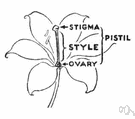ovary
(redirected from ovaries)Also found in: Thesaurus, Medical, Encyclopedia.
o·va·ry
(ō′və-rē)n. pl. o·va·ries
1.
a. One of the paired female reproductive organs that produce eggs and female sex hormones in humans and other vertebrates.
b. An analogous gland in an invertebrate animal, such as a flatworm or a mollusk.
2. Botany The ovule-bearing lower part of a pistil that ripens into a fruit.
American Heritage® Dictionary of the English Language, Fifth Edition. Copyright © 2016 by Houghton Mifflin Harcourt Publishing Company. Published by Houghton Mifflin Harcourt Publishing Company. All rights reserved.
ovary
(ˈəʊvərɪ)n, pl -ries
1. (Anatomy) either of the two female reproductive organs, which produce ova and secrete oestrogen hormones
2. (Zoology) the corresponding organ in vertebrate and invertebrate animals
3. (Botany) botany the hollow basal region of a carpel containing one or more ovules. In some plants the carpels are united to form a single compound ovary
[C17: from New Latin ōvārium, from Latin ōvum egg]
ovarian adj
Collins English Dictionary – Complete and Unabridged, 12th Edition 2014 © HarperCollins Publishers 1991, 1994, 1998, 2000, 2003, 2006, 2007, 2009, 2011, 2014
o•va•ry
(ˈoʊ və ri)n., pl. -ries.
1. the female gonad or reproductive gland, in which the ova and the female sex hormones develop.
2. the enlarged lower part of the pistil in flowering plants enclosing the ovules or new seeds.
[1650–60; < New Latin ōvārium]
Random House Kernerman Webster's College Dictionary, © 2010 K Dictionaries Ltd. Copyright 2005, 1997, 1991 by Random House, Inc. All rights reserved.
o·va·ry
(ō′və-rē)1. The reproductive organ in female animals that produces eggs and the sex hormones estrogen and progesterone. In most vertebrate animals, the ovaries occur in pairs.
2. The part of a flower pistil that contains ovules. The ovary is located at the base of the pistil and ripens into a fruit after fertilization of one or more of the ovules. See more at flower.
ovarian (ō-vâr′ē-ən) adjective
The American Heritage® Student Science Dictionary, Second Edition. Copyright © 2014 by Houghton Mifflin Harcourt Publishing Company. Published by Houghton Mifflin Harcourt Publishing Company. All rights reserved.
ovary
A walnut-sized sex organ which produces ova (eggs). Females have two ovaries, one on each side of the uterus.
Dictionary of Unfamiliar Words by Diagram Group Copyright © 2008 by Diagram Visual Information Limited
ThesaurusAntonymsRelated WordsSynonymsLegend:
Switch to new thesaurus
| Noun | 1. |  ovary - the organ that bears the ovules of a flower ovary - the organ that bears the ovules of a flowerblossom, flower, bloom - reproductive organ of angiosperm plants especially one having showy or colorful parts reproductive structure - the parts of a plant involved in its reproduction placenta - that part of the ovary of a flowering plant where the ovules form |
| 2. | ovary - (vertebrates) one of usually two organs that produce ova and secrete estrogen and progesterone craniate, vertebrate - animals having a bony or cartilaginous skeleton with a segmented spinal column and a large brain enclosed in a skull or cranium arteria ovarica, ovarian artery - the artery that branches from the aorta and supplies blood to the ovaries female reproductive system - the reproductive system of females female internal reproductive organ - the reproductive organs of a woman Graafian follicle - a vascular body in a mammalian ovary enclosing a developing egg |
Based on WordNet 3.0, Farlex clipart collection. © 2003-2012 Princeton University, Farlex Inc.
ovary
nounRelated words
adjective ovarian
adjective ovarian
Collins Thesaurus of the English Language – Complete and Unabridged 2nd Edition. 2002 © HarperCollins Publishers 1995, 2002
Translations
مَبيضمِبْيَضٌ
vaječníksemeník
æggestokovarium
munasarjasikiäin
jajnikovarij
petefészek
eggjastokkur
卵巣
난소
kiaušidė
olnīca
vaječník
jajnikјајник
äggstock
รังไข่ของสตรี
buồng trứng
Collins Spanish Dictionary - Complete and Unabridged 8th Edition 2005 © William Collins Sons & Co. Ltd. 1971, 1988 © HarperCollins Publishers 1992, 1993, 1996, 1997, 2000, 2003, 2005
Collins English/French Electronic Resource. © HarperCollins Publishers 2005
ovary
n
(Anat) → Eierstock m
(Bot) → Fruchtknoten m
Collins German Dictionary – Complete and Unabridged 7th Edition 2005. © William Collins Sons & Co. Ltd. 1980 © HarperCollins Publishers 1991, 1997, 1999, 2004, 2005, 2007
Collins Italian Dictionary 1st Edition © HarperCollins Publishers 1995
ovary
(ˈəuvəri) – plural ˈovaries – noun the part of the female body in which eggs are formed.
Kernerman English Multilingual Dictionary © 2006-2013 K Dictionaries Ltd.
ovary
→ مِبْيَضٌ vaječník æggestok Eierstock ωοθήκη ovario munasarja ovaire jajnik ovaio 卵巣 난소 ovarium eggstokk jajnik ovário яичник äggstock รังไข่ของสตรี yumurtalık buồng trứng 卵巢Multilingual Translator © HarperCollins Publishers 2009
o·va·ry
n. ovario, órgano reproductor femenino que produce el óvulo.
English-Spanish Medical Dictionary © Farlex 2012
ovary
n (pl -ries) ovarioEnglish-Spanish/Spanish-English Medical Dictionary Copyright © 2006 by The McGraw-Hill Companies, Inc. All rights reserved.